ISSN 2348-1218 (print)
International Journal of Interdisciplinary Research and Innovations ISSN 2348-1226 (online) Vol. 9, Issue 1, pp: (16-23), Month: January - March 2021, Available at: www.researchpublish.com

ISSN 2348-1218 (print)
International Journal of Interdisciplinary Research and Innovations ISSN 2348-1226 (online) Vol. 9, Issue 1, pp: (16-23), Month: January - March 2021, Available at: www.researchpublish.com
2
1PhD scholar, Department of Resource Management 2Associate Professor, Department of Resource Management 1,2SNDT Women’s University, Juhu, Mumbai – 400 049, Maharashtra, India
Abstract: Super stockist or Clearing and Forwarding Agent (CFA) is an agent who is accountable for managing and supplying stock of a pharmaceutical company. CFA workers are involved in packing and dispatch activities that require them to adopt postures such as bending back and legs, stooping, squatting, and kneeling on the floor. The purpose of this study was to analyse the work posture of CFA workers and assess the prevalence of musculoskeletal disorders (MSD) among them. CFA of a major pharmaceutical company located in the Bhiwandi area of Thane district in Maharashtra was surveyed. OWAS observation method was used to assess the postures adopted by workers. Prevalence of MSD among 30 male workers was determined using a modified Nordic questionnaire. 12 commonly adopted postures were identified from the video recording of work for OWAS analysis. OWAS revealed that two postures were in OWAS action category 4 (corrective action is required immediately), and three in OWAS action category 3 (corrective action is required as soon as possible). The results of the Nordic questionnaire showed that more than 60% of workers reported pain in the lower back, followed by pain in the knee and ankle. Workers at the CFA level are susceptible to postural risk due to their work and report pain in body parts. Therefore, there is a scope of ergonomic intervention: introduction of a workstation to eliminate risky postures.
Keywords: CFA, Pharmaceutical supply chain, Musculoskeletal Disorders (MSD), Work-related Musculoskeletal Disorders (WMSD), Posture, Ovako Work Assessment System (OWAS).
Indian pharmaceutical sector plays a vital role in the international pharmaceutical industry by meeting global demands. It exports drugs to over 200 countries and values over US$ 21 billion in the domestic market [1]. However, the industry lags when it comes to its supply or distribution element, which needs major overhauling. A supply chain or distribution system refers to the logistic part of transporting products from the manufacturer to the ultimate consumer [2]. The supply chain in the pharmaceutical industry has an agent called Clearing and Forwarding Agent (CFA), which maintains the stock (storage and supply) of a company. CFAs provide pharmaceutical products to stockists, and stockists provide them to retailers [3]. Workers at the CFA level are involved in packing pharmaceutical products to supply them to stockists and assume several postures to do their work.
Posture is the position a body assumes with the help of a group of muscles to maintain its stability [4]. Moreover, a work posture is the position adopted while working because it is appropriate for the work being done [5]. Musculoskeletal disorders (MSDs) represent health problems related to body parts such as muscles, tendons, the skeleton, cartilage, the vascular system, ligaments, and nerves. Work-related musculoskeletal disorders (WMSDs) cover MSDs either caused or worsened by work and work conditions [6]. Work conditions that lead to WMSD are repetitive movements and prolonged body postures. Musculoskeletal discomfort was reported among workers engaged in pharmaceutical packing operations [7, 8]. Workers were working in head and trunk flexed forward, and shoulders flexed and abducted position. The postural risk and presence of MSD were found to be associated with each other in this research [7]. RULA observation method and Nordic musculoskeletal questionnaire (NMQ) exhibited considerable postural risk and pain in the knee, back, neck, and other body areas among pharmaceutical packing workers [8, 9, 10]. Workstation in the pharmaceutical packaging industry
ISSN 2348-1218 (print)
International Journal of Interdisciplinary Research and Innovations ISSN 2348-1226 (online) Vol. 9, Issue 1, pp: (16-23), Month: January - March 2021, Available at: www.researchpublish.com
was observed to be unergonomic [8, 9]. Female workers in a potato cultivation plant working in stooping and squatting posture reported high MSD prevalence [11]. Ovako Work Assessment System (OWAS) was used to investigate work posture in a food manufacturing company, and a new ergonomic cart was designed based on the investigation results [12]. Tasks such as digging, loading-unloading, and mixing clay were video recorded and analysed using the OWAS method in brick-making factories [13]. OWAS posture assessment technique was used to assess MSD risk among various types of workers such as pistachio farmers, logistic workers, and employees of a car service workshop [14, 15, 16].
The objectives of this study were to - analyse postures of CFA workers using OWAS. - assess the prevalence of musculoskeletal disorders among CFA workers.
Descriptive research was designed using a survey and observation method. The locale of the study: A CFA unit located in Kalher village of Thane district of Maharashtra was chosen for the survey. Pharmaceutical supply chain management covers steps from the procurement of raw material to the provision of pharmaceutical products to consumers or patients [17]. A Clearing and Forwarding Agent (CFA) is an organization that plays the role of a middleman between a manufacturer and wholesalers/ stockists in a pharmaceutical supply chain. A CFA stores the pharmaceutical products of a company and forwards them to the stockists on request [3].
Sample and sample size: 30 male workers from the chosen CFA were interviewed to know their basic information and musculoskeletal discomforts using a modified Nordic questionnaire.
A Nordic questionnaire is an instrument used to record the musculoskeletal disorder symptoms among different types of workforces. A diagram of the human body showing nine body parts prone to musculoskeletal injuries: neck, shoulder, upper back, elbows, low back, wrist/hands, hips/ thighs, knees, and ankle/feet is shown to subjects, and they are asked to identify parts where they experience trouble [18]. Anthropometric measurements were taken using an anthropometric kit and weighing scale. OWAS was used to assess the work postures: a video recording of work was done, and snapshots from videos were taken every 5 seconds for a posture assessment. ErgoFellow software was used to evaluate postures using the OWAS tool.
Ovako steel company developed a method Ovako Work Assessment System (OWAS) for its employees. In this method, videos and photographs of work are taken to know the frequency and duration of postures adopted. Postures are then assessed based on predefined criteria. As explained in table 1, OWAS identifies commonly adopted postures: 4 for back, 3 for arms, 7 for legs, and assigns a single-digit code to each. OWAS also considers 3 levels of the load/weight handled by the worker while doing a task. 3 levels of the load handled are <10kg, 10-20 kg, and >20kg. A four-digit code is developed for all the combinations of the above-mentioned postures and loads. 252 combinations have been recognised and classified into four action categories indicating the required ergonomic action [19]. OWAS Action Categories (OAC) and the required corrective actions are shown in table 2.
ISSN 2348-1218 (print)
International Journal of Interdisciplinary Research and Innovations ISSN 2348-1226 (online) Vol. 9, Issue 1, pp: (16-23), Month: January - March 2021, Available at: www.researchpublish.com
Standing or squatting on two bent legs 5 Standing or squatting on one bent leg 6 Kneeling 7 Walking
Load category
OWAS score Load handled 1 Less than 10 kg 2 Between 10-20 kg 3 More than 20 kg
Source: Karhu, Kansi, and Kuorinka (1977)
Action category
Corrective action required 1 No action required 2 Action required in near future 3 Action required as soon as possible 4 Action required immediately
Source: Karhu, Kansi, and Kuorinka (1977)
The results of the survey and observation are as follows.
The job of workers at CFA is to pack medicines in cardboard boxes as per the lists given to them. As illustrated in table 3, workers do four activities: picking, checking, packing, and carrying to do their job. These four main activities are divided into 12 sub-activities or tasks. (table 3). One worker prepares 6-8 orders in an 8-hour workday, and one order takes 3 quarter-hours to one hour to prepare. Frequently adopted work postures are standing and sitting with a bent back, standing with one or both legs bent, squatting, and kneeling on the floor.
Activity Description Task Task Description
Picking Picking medicines as per the list from different parts of the warehouse and arranging them in one place
Checking Checking the collected items before packing them in boxes
Packing Packing medicines in cardboard boxes and sealing boxes with cello tape
Picking- Task 1 Making list of the medicines Picking- Task 2 Gathering medicines Picking- Task 3 Keeping medicines on floor
Checking- Task 1 Checking while sitting on a stool
Checking- Task 2 Checking while sitting on a stool
Packing- Task 1 Picking medicines from the floor
Packing- Task 2 Putting medicines in the box
Packing- Task 3 Sitting in kneeling position to arrange and warp the box
Packing- Task 4 Marking the box
Carrying Lifting cartons and moving them to a designated place for dispatch
Carrying- Task 1 Lifting the weight Carrying- Task 2 Carrying the weight Carrying- Task 3 Lowering the weight
ISSN 2348-1218 (print)
International Journal of Interdisciplinary Research and Innovations ISSN 2348-1226 (online) Vol. 9, Issue 1, pp: (16-23), Month: January - March 2021, Available at: www.researchpublish.com
Maximum load handled by the workers is less than 10 kg. Table 4 presents the general information and vital statistics of the workers.
TABLE IV: DEMOGRAPHIC
OF THE WORKERS (N=30)
Mean S.D. Mini Max Age 28.33 7.45 18 53 Work Experience 5.57 3.78 1 15 Salary 11500 3947.94 7000 20000 Education 11.8 2.04 10 17 Height 163.57 7.20 151.3 179.3 Weight 59.37 9.40 39 77 BMI 22.14 2.93 16.55 28.02
Parameter
As displayed in figure 1, a large percentage of workers reported pain in the lower back (66.7%) and knee (33.3%). Pain in ankles/feet; neck; shoulder; and upper back was also recorded by a small fraction, and pain in elbows; wrists; and hips/ thighs was not recorded at all.
Number and percentage of workers reporting pain in body parts
Fig. 1. Bar graph showing count and percentage of workers reporting pain in body parts

C. OWAS results
Results of OWAS analysis are presented in table 5. The table describes workers’ activities, tasks, posture adopted, OWAS score and action category assigned to each posture adopted, and action required. Two tasks were found to be in action category 4, suggesting corrective action required immediately. Three tasks were found to be in action category 3, meaning corrective action should be taken as soon as possible. The remaining tasks fell in action categories 1 and 2.
ISSN 2348-1218 (print)
International Journal of Interdisciplinary Research and Innovations ISSN 2348-1226 (online) Vol. 9, Issue 1, pp: (16-23), Month: January - March 2021, Available at: www.researchpublish.com
ActivityTask Posture adopted

PickingTask 1
Back bent
Both arms below shoulder level
Standing on one straight leg
Weight less than 10 kg
PickingTask 2 Back straight
Both arms below shoulder level
Walking Weight less than 10 kg
PickingTask 3
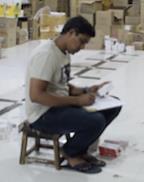

Back bent
Both arms below shoulder level
Standing or squatting on two bent legs
Weight less than 10 kg
OWAS Score OWAS Action Category Action required
corrective action required in near future
2131 2
1171 1
no action required
2141 3
CheckingTask 1
Back bent
Both arms below shoulder level
Sitting on the stool Weight less than 10 kg 2111 1
corrective action should be taken as soon as possible
no action required
CheckingTask 2
Back twisted
Both arms below shoulder level
Sitting on the stool Weight less than 10 kg
PackingTask 1

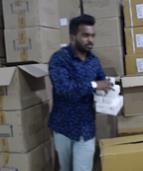

Back bent and twisted
Both arms below shoulder level
Standing or squatting on two bent legs
Weight less than 10 kg
3111 2
corrective action required in near future
4161 4
corrective action required immediately
ISSN 2348-1218 (print)
International Journal of Interdisciplinary Research and Innovations ISSN 2348-1226 (online) Vol. 9, Issue 1, pp: (16-23), Month: January - March 2021, Available at: www.researchpublish.com
PackingTask 2
Back bent and twisted
Both arms below shoulder level
Kneeling on the floor Weight less than 10 kg
4161 4
PackingTask 3
Back bent
Both arms below shoulder level
Kneeling on the floor Weight less than 10 kg
PackingTask 4 Back bent
Both arms below shoulder level
Standing on one straight leg Weight less than 10 kg
2161 2
corrective action required immediately
CarryingTask 1
Back bent
Both arms below shoulder level
Standing or squatting on two bent legs Weight less than 10 kg
CarryingTask 2 Back straight
One arm at or above shoulder level Walking Weight less than 10 kg
CarryingTask 3
Back bent
Both arms below shoulder level
Standing or squatting on two bent legs Weight less than 10 kg
2131 2
corrective action required in near future
2141 3
corrective action required in near future
1271 1
corrective action should be taken as soon as possible
no action required
2141 3
corrective action should be taken as soon as possible
This study showed that workers at CFA level in pharmaceutical distribution channel adopt various risky postures and suffer from musculoskeletal problems. MSD prevalence was found to be high in lower back, knee, and ankle/feet. In a previous study of pharmaceutical packing workers, MSD prevalence in the knee (44.7%), back (36.8%), and neck (31.6%) was observed [8]. 310 workers of a brick kiln were studied using NMQ, and lower back pain followed by knee pain were found to be the most common among workers. The common work postures that brick kiln workers adopted were squatting (67%), stooping (19%), and standing (14%) [20]. Musculoskeletal problems were seen in the neck, back,
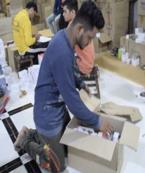

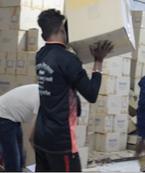

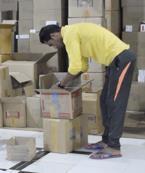
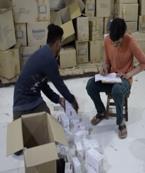
ISSN 2348-1218 (print)
International Journal of Interdisciplinary Research and Innovations ISSN 2348-1226 (online) Vol. 9, Issue 1, pp: (16-23), Month: January - March 2021, Available at: www.researchpublish.com
hand, and feet of the workers of a corn chips factory [21]. Complains of pain in the back-34%, shoulder-20%, knee-20%, neck-16% were noticed in a study conducted on the delivery men of Liquid Petroleum Gas (LPG) in India [22].
Two packing tasks were found to be in OWAS action categories 4. Three tasks, one picking and two carrying, were found to be in OWAS action category 3. These tasks require workers to keep back and twisted, one or two legs bent and twisted while standing, and kneeling or squatting on the floor (table 5). This implies a workstation that helps workers avoid bending, kneeling, and squatting can improve work posture. The high prevalence of pain in the lower back, knee, and ankle suggests that bending and kneeling, and squatting are the main concerns that need to be addressed.
According to the OWAS analysis in this study, 25% posture (OAC 3) require corrective action as soon as possible and 17% posture (OAC 4) require corrective action immediately. In a corn chips factory, 26% activities were in category 3 and category 4 [21]. LPG service workers adopt awkward postures such as back bent and twisted, the arms above the shoulder level, standing or squatting on both legs with knees bent, and lift a load > than 20 kgs. Therefore, OWAS showed 90% postures in AC4 and 70% postures in AC3 for them [22]. In a study of 100 workers of a tobacco factory, where musculoskeletal complaints were high in low back (55%), knees (45%) and shoulders (37%), OWAS showed that 26.8% body postures were harmful and 5.1% body postures were very harmful [23]. OWAS study of posture of washroom cleaners in malls revealed that activities requiring standing on toes, bending, twisting, stooping and leaning with arms abducted below shoulder level and above shoulder level were in OWAS action category 3 and required corrective measures as soon as possible [24]. OWAS results were used to design an ergonomic intervention in a food manufacturing company in Iran [12].
Results of this study assert that workers in the pharmaceutical supply chains suffer from musculoskeletal disorders. OWAS results reveal that the postures adopted by the workers need modification. An ergonomic intervention a workstation that avoids bending, stooping, squatting, and kneeling is needed to correct workers’ postures and lessen musculoskeletal pain.
[1] Indian Pharmaceuticals industry analysis. Available at: https://www.ibef.org/industry/indian-pharmaceuticalsindustry-analysis-presentation.
[2] Indian Pharma Companies Need Supply Chain Transformation. Available at: https://www.pharmafocusasia.com/ strategy/supply-chain-transformation
[3] Pharmaceutical Distribution in India. Available at: http://www.biopharminternational.com/pharmaceuticaldistribution-india
[4] M. D. Gardiner. The principles of exercise therapy. London: G. Bell and Sons, 1957.
[5] E. N. Corlett Stress, Work Design and Productivity London: Wiley, 1981
[6] OSH in figures: Work-related musculoskeletal disorders in the EU Facts and figures. Available at: https://osha. europa.eu/en/publications/osh-figures-work-related-musculoskeletal-disorders-eu-facts-and-figures
[7] Velaga P, Telaprolu N (2013) Work posture and prevalence of musculoskeletal symptoms among women in packing activities of pharmaceutical industry IJCRR 5(17):57-64
[8] Varmazyar S, Varyani AS, Zeidi IM (2009) Evaluation of working posture and musculoskeletal disorders prevalence in pharmacy packaging workers. European Journal of Scientific Research 29(1):82-88.
[9] Kheiri H, Moshfegh H, Hatami H, Ranjbarian M (2014) Investigation of relationship between musculoskeletal disorders and working conditions among workers at a pharmaceutical industry in Iran. Iranian Journal of Health, Safety, and Environment 1(3):145-150.
[10] Pourmahabadian M, Akhavan M, Azam K (2008) Investigation of risk factors of work-related upper-limb musculoskeletal disorders in a pharmaceutical industry. Journal of Applied Sciences 8(7): 1262-1267.
ISSN 2348-1218 (print) International Journal of Interdisciplinary Research and Innovations ISSN 2348-1226 (online) Vol. 9, Issue 1, pp: (16-23), Month: January - March 2021, Available at: www.researchpublish.com
[11] Pal A, De S, Sengupta P et al (2015) Evaluation of work-related musculoskeletal disorder and postural stress among female potato cultivators in West Bengal, India. Ergonomics SA 27(1):46-64.
[12] Naeini HS (2015) Occupational health promotion throughout an interventional ergonomic design (case study: an ergonomic cart design at a food manufacturing company in Iran). International Journal of Occupational Hygiene 7(4):172-176.
[13] Pandey K, Vats A (2012) An OWAS based analysis of workers engaged in brick making factories, Faizabad district of Uttar Pradesh, India. J Ergonomics 2(2).
[14] Beheshti MH, Firoozi AC, Alinaghi Langari AA, Poursadeghiyan M (2015) Risk assessment of musculoskeletal disorders by OVAKO Working posture Analysis System OWAS and evaluate the effect of ergonomic training on posture of farmers. JOHE 4 (3): 131-138
[15] Lasota AM (2013) Packer’s workload assessment, using the OWAS method Logistics and Transport No 2(18): 2531.
[16] Kohnavard B, Shegerd M, Mousavian Asl Z (2018) Ergonomic assessment of body working postures among the employees of a car services workshop using OWAS technique. International Journal of Musculoskeletal Pain Prevention 3(1):19-22.
[17] India wants to become a very significant player in the global supply chain of pharmaceuticals: Dr Sanjit Singh Lamba. Available at: https://health.economictimes.indiatimes.com/news/pharma/india-wants-to-become-a-verysignificant-player-in-the-global-supply-chain-of-pharmaceuticals-dr-sanjit-singh-lamba/70458521
[18] Kuorinka I, Jonsson B, Kilbom A et al (1987) Standardized Nordic questionnaires for the analysis of musculoskeletal symptoms. Applied Ergonomics 18(3):233–237
[19] Karhu O, Kansi P, Kuorinka I (1977) Correcting working postures in industry: a practical method for analysis. Applied Ergonomics 8(4):199-201.
[20] Inbaraj LR, Haebar OJ, Saj F et al (2013) Prevalence of musculoskeletal disorders among brick kiln workers in rural southern India. Indian Journal of Occupational and Environmental Medicine 17(2):71-75.
[21] Wahyudi MA, Dania WAP, Silalahi RLR (2015). Work posture analysis of manual material handling using OWAS method Agriculture and Agricultural Science Procedia 3: 195-199.
[22] Salian SC, Boricha J, Yardi S (2012) Identification of awkward postures that cause discomfort to liquid petroleum gas workers in Mumbai, India. Indian Journal of Occupational and Environmental Medicine 16(1):3-8.
[23] Etemadinezhad S, Ranjbar F, Gorji M (2013) Posture analysis by OWAS method and prevalence of musculoskeletal disorders among workers of Sourak tobacco factory in 2013. Iranian Journal of Health Sciences 1(2):89-94.
[24] Chauhan MK, Patel P (2015) Work related musculoskeletal problems faced by the washroom cleaners working in malls. International Journal of Healthcare Sciences 3(1):292-299.